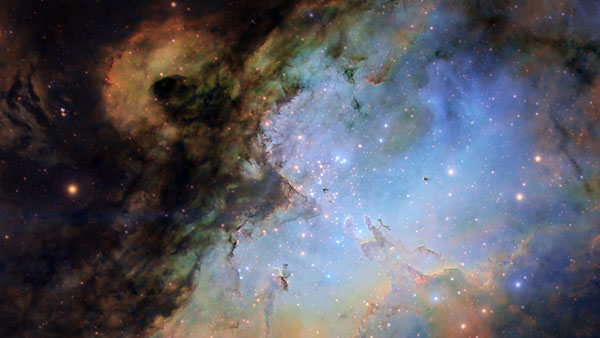By Satyabrat Borah
The idea that 95% of the universe might be an illusion is the kind of statement that makes you pause and rethink everything you thought you knew about the cosmos. For decades, scientists have believed that the universe is mostly made up of invisible stuff, things we can’t see or touch, called dark matter and dark energy. Together, these mysterious components are thought to account for roughly 95% of the universe’s total mass and energy, shaping its structure and driving its expansion. But what if this widely accepted picture is wrong? What if dark matter and dark energy don’t exist at all? That’s the bold claim made by physicist Rajendra Gupta, whose new theory challenges the very foundations of modern cosmology and offers a simpler way to explain the universe’s behavior.
For a long time, the standard model of cosmology has relied on the concept of dark matter and dark energy to make sense of observations that don’t add up otherwise. Dark matter, for instance, was proposed to explain why galaxies behave the way they do. When astronomers studied the rotation of galaxies, they noticed something puzzling: the stars at the edges of galaxies were moving much faster than expected. Based on the visible matter—stars, gas, and dust—there simply wasn’t enough gravity to hold these galaxies together at such high speeds. To solve this mystery, scientists hypothesized the existence of dark matter, an invisible substance that adds extra gravity, keeping galaxies from flying apart. Dark energy, on the other hand, came into the picture to explain why the universe is expanding at an accelerating rate, a discovery that shocked scientists in the late 1990s. Together, dark matter and dark energy became the cornerstones of our understanding of the cosmos, even though no one has ever directly detected them.
But here’s where things get interesting. Rajendra Gupta, a physicist who’s been digging into the mysteries of the universe, argues that we might not need dark matter or dark energy at all. In a paper that’s been making waves in the scientific community, Gupta proposes a new model that explains the same observations using a single equation and a variable parameter he calls α (alpha). This parameter changes slightly depending on the scale of what you’re looking at, whether it’s the vast distances between galaxies or the intricate dynamics within a single galaxy. According to Gupta, this one equation can account for both the accelerated expansion of the universe and the peculiar rotation patterns of galaxies, without relying on invisible particles or mysterious energy.
Let’s break this down a bit. Imagine you’re looking at a galaxy, a massive swirl of stars, gas, and dust spinning in space. The stars at the outer edges of the galaxy are moving so fast that, based on the visible matter, they should be flung out into space. But they aren’t. For years, scientists attributed this to dark matter, picturing it as an invisible halo surrounding the galaxy, providing the extra gravity needed to keep everything in place. Gupta’s theory, however, suggests a different explanation. He argues that the gravitational effects we attribute to dark matter are actually caused by variations in his α parameter, which depends on how normal matter is distributed. In denser regions of a galaxy, like the core where stars are packed tightly, the gravitational effects remain pretty standard. But in less dense regions, like the outer edges, the α parameter adjusts in a way that produces stronger gravity, mimicking the effect of dark matter. This neatly explains the rotation curves of galaxies, those graphs that show how fast stars are moving at different distances from the galaxy’s center, without needing to invoke an invisible substance.
This idea is pretty radical because it challenges a concept that’s been a cornerstone of cosmology for decades. Dark matter isn’t just a convenient explanation for galaxy rotation; it’s also thought to play a key role in how galaxies form and cluster together. Observations like gravitational lensing, where light from distant objects bends as it passes through massive galaxy clusters, and the patterns in the cosmic microwave background, the faint glow left over from the Big Bang, have all been interpreted as evidence for dark matter. Gupta’s model, if correct, would need to explain these phenomena just as well, if not better, than the current dark matter model. That’s a tall order, and it’s one of the reasons why his theory is sparking so much debate.
Now, let’s talk about dark energy, the other big player in the standard cosmological model. In the late 1990s, astronomers discovered that the universe isn’t just expanding—it’s expanding faster and faster over time. This was a huge surprise because you’d expect gravity to slow down the expansion, not speed it up. To explain this acceleration, scientists came up with the idea of dark energy, a mysterious force that pushes galaxies apart. It’s thought to make up about 68% of the universe, but like dark matter, it’s never been directly observed. Gupta’s theory takes a different approach. Instead of dark energy, he suggests that the fundamental forces of nature, like gravity itself, might weaken over time. This decay of fundamental forces could produce the same effect as dark energy, driving the universe’s accelerated expansion. By tweaking his α parameter, Gupta’s model can account for this phenomenon without introducing a new, unseen form of energy.
What makes Gupta’s theory so intriguing is its simplicity. The standard model of cosmology, while incredibly successful, is a bit like a puzzle with some awkwardly fitting pieces. Dark matter and dark energy are placeholders for things we can’t see or measure directly, which makes some scientists uneasy. Gupta’s approach, by contrast, tries to explain everything with a single equation and a variable that adjusts based on context. It’s an elegant idea, almost like finding a master key that unlocks multiple doors. If it holds up, it could simplify our understanding of the universe dramatically, reducing the need for exotic, invisible components.
But simplicity alone isn’t enough in science. Any new theory has to face rigorous testing, and Gupta’s ideas are no exception. The standard model, with its dark matter and dark energy, has been incredibly successful in explaining a wide range of observations, from the formation of galaxies to the large-scale structure of the universe. Gupta’s model will need to match or outperform these explanations, and that’s where the challenge lies. Scientists will want to see how well his equation holds up against data from galaxy clusters, gravitational lensing, and the cosmic microwave background. They’ll also want to test whether his model can predict new observations, something the standard model has done with remarkable accuracy. For now, Gupta’s theory is a bold hypothesis, but it’s far from being widely accepted.
The scientific community is buzzing with discussions about this new perspective. Some see it as a refreshing challenge to long-held assumptions, while others are skeptical, pointing out that dark matter and dark energy have been supported by decades of observations. The debate is healthy, though, because it pushes science forward. Every major breakthrough in our understanding of the universe has come from questioning what we think we know. Einstein’s theory of relativity, for example, overturned Newton’s ideas about gravity, and it took years of testing before it was fully embraced. Gupta’s theory might follow a similar path, or it might spark new ideas that lead to an even better model.
What’s exciting about this is what it says about science itself. The universe is a vast, mysterious place, and our understanding of it is always evolving. Gupta’s work reminds us that even the most established ideas can be questioned, and sometimes, the simplest explanations turn out to be the most profound. Whether his theory proves to be correct or not, it’s a testament to the curiosity and creativity that drive scientific discovery. For now, the idea that 95% of the universe might be an illusion is a fascinating possibility, one that invites us to look at the cosmos with fresh eyes and wonder what other secrets it’s hiding.




